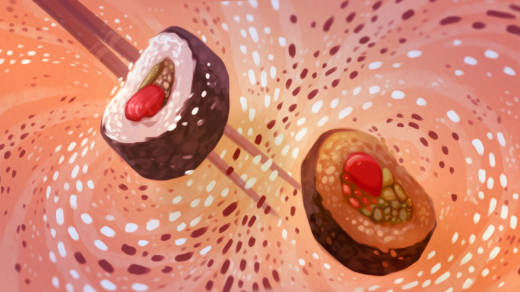Meat was seldom on the menu when I was a kid. When we did eat it, my family's go-tos consisted of hot dogs (consumed once per year at my dad's work picnic), kung pao chicken from various local Chinese establishments, and my mom's tandoori chicken slathered in yogurt sauce. These dishes all followed my formerly vegetarian, reluctantly omnivorous Hindu parents' Cardinal Rule for Eating Meat: Meat should not resemble animal. Skin and bones were to be avoided, which meant that chicken wings and ribs were inherently problematic, as were Thanksgiving turkeys, which were replaced with lasagnas.
Sushi was never on the radar (fish as a whole was out, given its fishy qualities), but it ostensibly fit the Cardinal Rule, given that the fish was skinless and boneless. And best of all, it was covered in rice, the best food known to (Indian) man (and woman). I tried sushi for the first time in the summer of 2001 in an upstate New York college town to prepare for my forthcoming teaching stint in Japan. (Since I'd gone completely vegetarian in high school, it was also the first piece of animal flesh I had eaten in seven years). To be honest, I don't remember the taste of the sushi as much as the experience, which, as the years have passed, has lodged in the part of my brain reserved for nostalgia.
Sometime upon my return stateside two years later, an abomination began to appear on the menus of local sushi joints: brown rice rolls. The holy triad of salt, sugar, and vinegar had gone out of whack; the rice grains tasted like grit.
So I was shocked (shocked!) when a friend of mine told me that he liked brown rice sushi. An Indian, fellow rice-loving friend. A friend who should know better. Was it really possible, I began to wonder, to make brown rice sushi taste as good as its white rice counterpart?
Early iterations of sushi might have been made with brown rice, says Mori Onodera, former chef and owner of Michelin-starred restaurant Mori Sushi in Los Angeles and current co-owner of Tamaki Farms, Inc., a rice farm in Uruguay. But in modern times, making the perfect sushi roll means balancing the flavors and textures of the rice on the outside and the fish, vegetable, or egg on the inside. Brown rice, says Onodera, upsets that delicate balance.
